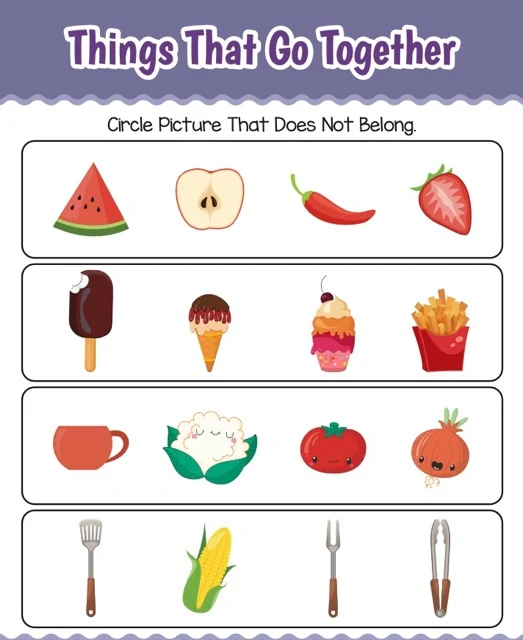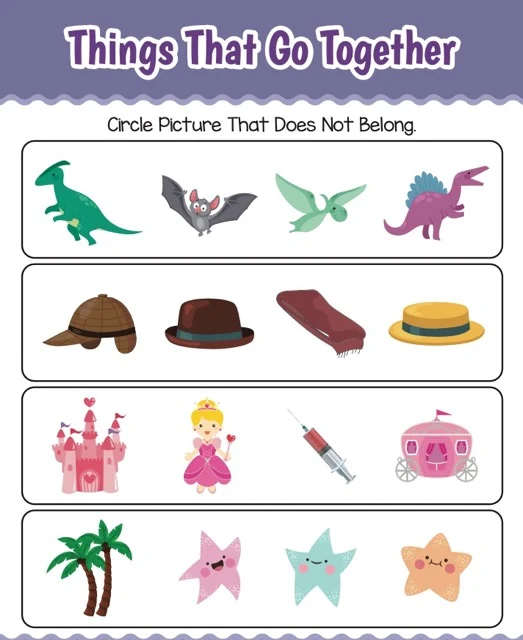Teaching Children Relationships
This briefing document and accompanying excerpts explain the importance of teaching children about "Things That Go Together," a concept crucial for cognitive development. It details how understanding relationships between objects (e.g., functional, categorical, locational) enhances logical thinking, problem-solving, and vocabulary. Effective teaching methods, including engaging games and visual aids, are highlighted, along with the cross-curricular applications and real-world benefits of this concept. The sources emphasize that this skill is essential for navigating daily life effectively.
Things That Go Together: Cognitive Development and Connections
Briefing Doc: Things That Go Together
Main Themes:
●
Cognitive Development: The concept of "Things That Go Together" plays a crucial role in cognitive development, fostering logical thinking, reasoning skills, vocabulary expansion, and observational abilities. It helps children understand the world around them by identifying relationships between various objects, concepts, and ideas.
●
Relationship Types: "Things That Go Together" are linked by various relationships, including function (e.g., toothbrush and toothpaste), category (e.g., apples and oranges), location (e.g., beach and sand), and common usage (e.g., milk and cookies).
●
Teaching Methods: Effective teaching methods utilize engaging activities like matching games, sorting activities, "odd one out" games, storytelling, and real-life examples. Visual aids such as pictures, illustrations, and real objects enhance the learning experience, especially for visual learners.
●
Cross-Curricular Applications: This concept can be integrated into diverse subject areas. In science, it helps understand food chains and ecosystems. In math, it aids in learning number pairs and geometric shapes. In language arts, it assists in identifying rhyming words and synonyms.
●
Real-World Applications: Understanding "Things That Go Together" equips children with practical skills for daily life, enabling them to organize belongings, follow instructions, make predictions, solve problems logically, and communicate effectively.
Important Ideas/Facts:
●
Enhancing Vocabulary: "When children learn about 'Things That Go Together', they encounter new vocabulary related to the items and their relationships." (Understanding Things That Go Together - Answer Key)
●
Visual Aids for Visual Learners: "Visual learners grasp information best when they can see it represented. Visual aids like pictures and real objects help these children form a mental image of the 'Things That Go Together', making the concept more concrete and easier to understand." (Understanding Things That Go Together - Answer Key)
●
Real-Life Connections: "Relating 'Things That Go Together' to real-life experiences makes the learning more relevant and meaningful." (Understanding Things That Go Together - Answer Key)
●
Benefits in Daily Life: "Understanding this concept helps children organize their belongings by categorizing them. It also aids in following instructions by understanding the sequence of steps that go together to complete a task." (Understanding Things That Go Together - Answer Key)
Quotes:
●
Definition: "'Things That Go Together' refers to objects, concepts, or ideas that have a natural association or relationship with each other." (Things That Go Together: A Guide for Educators and Parents)
●
Importance: "Understanding relationships between different things is crucial for cognitive development." (Things That Go Together: A Guide for Educators and Parents)
●
Engaging Activities: "Various fun and engaging activities can be used, such as: Matching games, Sorting activities, 'Odd one out' games, Storytelling, Real-life examples." (Things That Go Together: A Guide for Educators and Parents)
Conclusion:
Teaching "Things That Go Together" is not just an educational exercise but an essential building block for a child's cognitive development and their ability to navigate the world effectively. By understanding the relationships between different things, children develop essential skills for learning, problem-solving, and daily living.
Things That Go Together: A Guide for Educators and Parents
Things That Go Together FAQ
1. What are "Things That Go Together"?
"Things That Go Together" refers to objects, concepts, or ideas that have a natural association or relationship with each other. These relationships can be based on various factors such as function, category, location, or common usage.
2. What is the purpose of learning about "Things That Go Together"?
Understanding relationships between different things is crucial for cognitive development. It helps children:
●
Develop logical thinking and reasoning skills.
●
Enhance vocabulary and language comprehension.
●
Improve observation and categorization abilities.
●
Understand the world around them better.
3. What are some examples of "Things That Go Together"?
Examples include:
●
Function: Knife and fork, pen and paper, toothbrush and toothpaste.
●
Category: Apples and oranges (fruits), cats and dogs (animals), chairs and tables (furniture).
●
Location: Beach and sand, forest and trees, city and buildings.
●
Common usage: Milk and cookies, bread and butter, thunder and lightning.
4. How can "Things That Go Together" be taught to children?
Various fun and engaging activities can be used, such as:
●
Matching games: Matching objects or pictures that go together.
●
Sorting activities: Grouping items based on their relationships.
●
"Odd one out" games: Identifying the item that doesn't belong to a particular group.
●
Storytelling: Creating stories that involve things that go together.
●
Real-life examples: Pointing out relationships between things in everyday situations.
5. What are the benefits of using visual aids when teaching "Things That Go Together"?
Visual aids, such as pictures, illustrations, and real objects, can:
●
Make learning more engaging and interesting for children.
●
Help children visualize and understand the concepts better.
●
Cater to different learning styles, particularly visual learners.
●
Provide a concrete reference point for abstract concepts.
6. How can the concept of "Things That Go Together" be applied in different subject areas?
●
Science: Learning about food chains, ecosystems, and the parts of a plant.
●
Math: Understanding number pairs, geometric shapes, and measurement units.
●
Language Arts: Identifying rhyming words, synonyms, and antonyms.
●
Social Studies: Exploring different cultures, communities, and historical events.
7. What are some tips for parents and educators to effectively teach "Things That Go Together"?
●
Start with simple examples and gradually increase the complexity.
●
Use a variety of teaching methods to keep children engaged.
●
Encourage children to think critically and explain their reasoning.
●
Relate the concepts to real-life experiences and observations.
●
Make learning fun and enjoyable!
8. How does understanding "Things That Go Together" benefit children in their daily lives?
It helps them:
●
Organize their belongings and keep things in order.
●
Follow instructions and complete tasks effectively.
●
Make predictions and solve problems logically.
●
Communicate their ideas clearly and effectively.
●
Develop a deeper understanding of the world and its interconnectedness.
Understanding Things That Go Together
Understanding Things That Go Together
Short-Answer Quiz
Instructions: Answer each question in 2-3 sentences.
1.
What is meant by the term "Things That Go Together"?
2.
Describe two different types of relationships that can exist between things that go together.
3.
Explain how teaching "Things That Go Together" helps to enhance a child's vocabulary.
4.
Give two examples of "Things That Go Together" that demonstrate the concept of "function".
5.
How can storytelling be used as a method to teach "Things That Go Together"?
6.
Explain why visual aids are particularly helpful for visual learners.
7.
Provide an example of how "Things That Go Together" can be applied in a science lesson.
8.
How does understanding this concept help children in their daily lives outside of the classroom?
9.
Why is it beneficial to relate the concept of "Things That Go Together" to real-life experiences?
10.
Suggest one tip for an educator who wants to make learning about "Things That Go Together" more enjoyable for their students.
Answer Key
1.
"Things That Go Together" refers to items, concepts, or ideas that have a natural connection or relationship. This connection can be based on shared function, belonging to the same category, being found in the same location, or frequent pairing in daily life.
2.
One type of relationship is based on function, where items are linked because they are used together for a specific purpose, like a hammer and nail. Another type is category, where items belong to a similar group, such as apples and oranges both being fruits.
3.
When children learn about "Things That Go Together", they encounter new vocabulary related to the items and their relationships. For example, learning about "knife and fork" introduces the words for these utensils and the concept of using them together for eating.
4.
Toothbrush and toothpaste go together because they are both used for cleaning teeth. Pen and paper are used together for writing.
5.
Teachers or parents can create stories that involve characters using or encountering things that go together. For instance, a story about a chef preparing a meal could naturally include "Things That Go Together" found in a kitchen.
6.
Visual learners grasp information best when they can see it represented. Visual aids like pictures and real objects help these children form a mental image of the "Things That Go Together", making the concept more concrete and easier to understand.
7.
In a science lesson about plants, students could learn about the different parts of a plant and how they work together for the plant's survival. For example, the roots absorb water, the stem transports it, and the leaves use sunlight to make food.
8.
Understanding this concept helps children organize their belongings by categorizing them. It also aids in following instructions by understanding the sequence of steps that go together to complete a task.
9.
Relating "Things That Go Together" to real-life experiences makes the learning more relevant and meaningful. Children can better connect abstract concepts to their own observations and daily routines.
10.
Educators can make learning enjoyable by incorporating games, interactive activities, and hands-on experiences. For example, a matching game or a sorting activity can make learning about "Things That Go Together" fun and engaging.
Essay Questions
1.
Discuss the importance of teaching "Things That Go Together" in early childhood education. How does this concept contribute to a child's overall development?
2.
Compare and contrast three different methods for teaching "Things That Go Together", highlighting the advantages and disadvantages of each method.
3.
Analyze the role of visual aids in teaching this concept. Explain how visual aids can be effectively used to cater to different learning styles.
4.
Choose a specific subject area (e.g., science, math, language arts) and discuss how the concept of "Things That Go Together" can be integrated into lesson plans to enhance learning.
5.
Explain how understanding "Things That Go Together" prepares children for future learning and problem-solving in more complex situations.
Glossary of Key Terms
●
Association: A connection or relationship between two or more things.
●
Categorization: The process of grouping things based on shared characteristics.
●
Cognitive Development: The growth of mental processes such as thinking, learning, and problem-solving.
●
Concept: A general idea or understanding of something.
●
Function: The purpose or use of something.
●
Logical Thinking: The ability to reason and make deductions based on evidence and rules.
●
Relationship: The way in which two or more things are connected.
●
Visual Aid: An educational tool that uses visual elements to help explain concepts.
●
Vocabulary: The set of words a person knows and understands.























